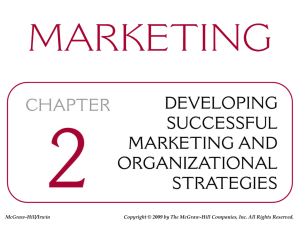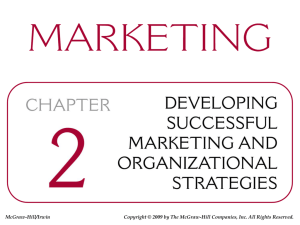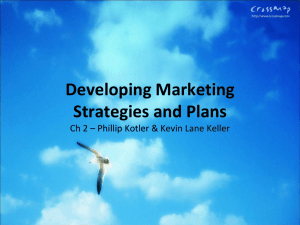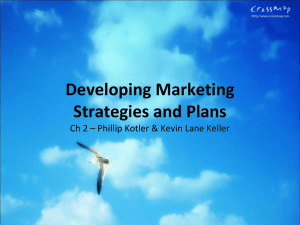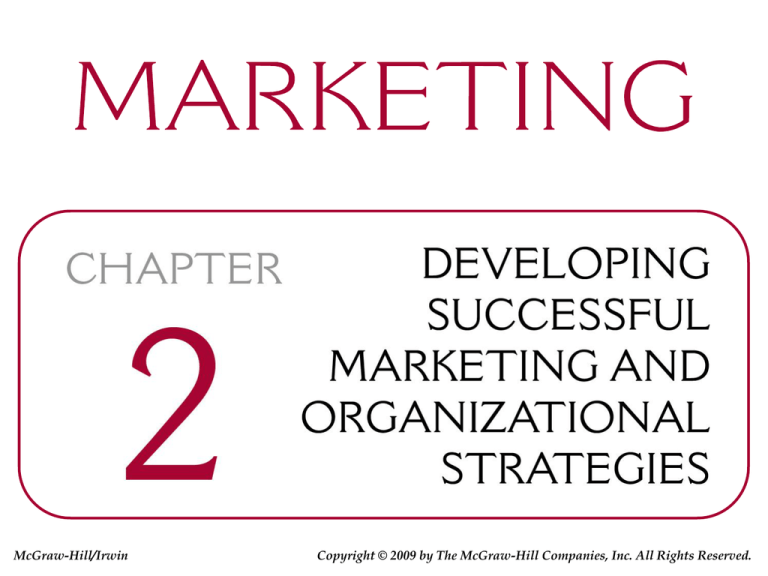
McGraw-Hill/Irwin
Copyright © 2009 by The McGraw-Hill Companies, Inc. All Rights Reserved.
TODAY’S ORGANIZATIONS
LO1
STRUCTURE—CORPORATE
Corporate Level
Chief Marketing Officer (CMO)
Cammie Dunaway
Yahoo!
Eduardo Conrado
Motorola Networks
Leslie Short
FUBU
2-2
Strategic Business Unit (SBU) Level
The strategic business unit
(SBU) level is the level in an
organization where managers set
a more specific strategic direction
for their businesses to exploit
value creating opportunities.
2-3
TODAY’S ORGANIZATIONS
LO1
STRUCTURE—SBU
Strategic Business Unit (SBU)
Strategic Business Unit (SBU) Level
GE Commercial Finance
GE Industrial
GE Money
(business loans, leases)
(appliances, lighting,
factory automation)
(consumer home loans,
credit cards)
GE Healthcare
GE Infrastructure
GE NBC Universal
(imaging, diagnostics,
life-support systems)
(aircraft engines, energy,
transportation)
(television, music, film)
2-4
Strategic Business Unit (SBU)
A strategic business unit (SBU)
is a subsidiary, division, or unit of
an organization that markets a set
of related offerings to a clearlydefined group of customers.
2-5
LO1
TODAY’S ORGANIZATIONS
STRUCTURE—FUNCTIONAL
Functional Level
Department
•
Cross-Functional Teams
2-6
FIGURE 2-1 The board of directors oversees
the three levels of strategy in organizations:
corporate, business unit, and functional
2-7
FIGURE 2-2 Visionary organizations:
(1) establish a foundation, (2) set a direction,
and (3) create strategies
2-8
STRATEGY IN VISIONARY
ORGANIZATIONS
LO2
FOUNDATION (WHY)
Core Values
Nike- to experience the emotion of
competition, winning and crushing
competitors
Mission or Vision
Organizational Culture
2-9
Star Trek Enterprise
Why is a mission statement important?
2-10
LO2
STRATEGY IN VISIONARY
ORGANIZATIONS
DIRECTION (WHAT)
Business
• What do we do?
• What business
are we really in?
2-11
LO2
STRATEGY IN VISIONARY
ORGANIZATIONS
DIRECTION (WHAT)
Goals or Objectives: S.M.A.R.T
• Specific
• Measurable
• Attainable
• Relevant
• Time-based
2-12
LO2
STRATEGY IN VISIONARY
ORGANIZATIONS
DIRECTION (WHAT)
Goals or Objectives: Types
• Profit
• Customer Satisfaction
• Sales ($ or #)
• Employee Welfare
• Market Share
• Social Responsibility
• Quality
• Efficiency
2-13
LO3
SETTING STRATEGIC DIRECTIONS
WHERE ARE WE NOW?
Competencies (capabilities, skills,
technologies and resources that
distinguish us from other organization
• Competitive Advantage
• Fast Cycle Time
• Quality
• Benchmarking
2-14
SETTING STRATEGIC DIRECTIONS
LO3
WHERE ARE WE NOW?
Customers
Competitors
2-15
LO3
SETTING STRATEGIC DIRECTIONS
WHERE DO WE WANT TO GO? SBU Evaluation
Business Portfolio Analysis (BCG)
High
Market Growth Rate
Stars
Question Marks
Cash Cows
Dogs
Low
High
Low
Relative Market Share
2-16
FIGURE 2-3 BCG business portfolio
analysis for Kodak’s consumer SBUs for
2003 (solid circle) and 2010 (hollow circle)
②
Kodak digital
camera
①
Kodak film sales: US,
Canada, & W. Europe
③
Kodak digital
photo printer
④
Kodak selfservice kiosk
2-17
LO3
SETTING STRATEGIC DIRECTIONS
WHERE DO WE WANT TO GO?
Hedgehog Analysis
• What Can We Be the Best At in the World?
• What Drives Our Economic Engine?
• What Are We Deeply Passionate About?
2-18
LO3
SETTING STRATEGIC DIRECTIONS
WHERE DO WE WANT TO GO?
Blue Ocean Analysis
• Red Oceans –where we are
• Blue Oceans-where we want to be
Copyright 2005 W. Chan Kim and Renée Mauborgne
2-19
LO3
SETTING STRATEGIC DIRECTIONS
TRACKING WITH MARKETING DASHBOARDS
Car Dashboards and
Marketing Dashboards
Marketing Metrics and Graphics in
Designing Marketing Dashboards
Marketing Plan
2-20
FIGURE 2-4 An effective marketing
dashboard like Oracle’s helps managers
assess a business situation at a glance
2-21
USING MARKETING DASHBOARDS
Which States are Underperforming?
Annual Percent Change in Unit Volume by State
New Sales Š Old Sales
Annual % Sales Change =
Old Sales
100
Change in Growth
> 10%
0 – 10%
< 0%
2-22
FIGURE 2-5 (Condensed) The strategic
marketing process has three phases:
planning, implementation, and evaluation
2-23
LO4
THE STRATEGIC MARKETING PROCESS
Strategic Marketing Process
• How Do We Allocate Our Resources
to Get Where We Want to Go?
• How Do We Convert Our Plans to Actions?
• How Do Our Results Compare With
Our Plans, and Do Deviations Require
New Plans?
2-24
LO4
THE STRATEGIC MARKETING PROCESS
THE PLANNING PHASE
Step 1: Situation (SWOT) Analysis
• Situation Analysis
• SWOT Analysis
Strengths
Weaknesses
Opportunities
Threats
2-25
LO4
THE STRATEGIC MARKETING PROCESS
THE PLANNING PHASE
Step 1: Situation (SWOT) Analysis
• SWOT Analysis Study
Identify Industry Trends
Analyze Competitors
Assess the Organization
Research Present and
Prospective Customers
2-26
FIGURE 2-6 Ben & Jerry’s SWOT analysis
that serves as the basis for management
actions regarding growth
2-27
LO4
THE STRATEGIC MARKETING PROCESS
THE PLANNING PHASE
Step 1: Situation (SWOT) Analysis
• SWOT Analysis Study
Build on a Strength
Correct a Weakness
Exploit an Opportunity
Avoid a DisasterLaden Threat
2-28
LO4
THE STRATEGIC MARKETING PROCESS
THE PLANNING PHASE
Step 2: Market-Product Focus and
Goal Setting
• Market Segmentation
• Points of Difference
2-29
LO4
THE STRATEGIC MARKETING PROCESS
THE PLANNING PHASE
Example: Medtronic’s Pacemaker
• Set Marketing & Product Goals
• Select Target Markets
• Find Points of Difference
• Position the Product
2-30
LO5
THE STRATEGIC MARKETING PROCESS
THE PLANNING PHASE
Step 3: Marketing Program
• Product Strategy
• Price Strategy
• Promotion Strategy
• Place (Distribution) Strategy
2-31
FIGURE 2-7 The elements of the marketing
mix must be blended to produce a cohesive
marketing program
2-32
LO5
THE STRATEGIC MARKETING PROCESS
THE IMPLEMENTATION PHASE
Obtaining Resources
Designing the Marketing Organization
Developing Schedules
Executing the Marketing Program
• Marketing Strategy
• Marketing Tactics
2-33
LO5
THE STRATEGIC MARKETING PROCESS
THE EVALUATION PHASE
Comparing Results with Plans to
Identify Deviations
• Planning Gap
Acting on Deviations
• Exploiting a Positive Deviation
• Correcting a Negative Deviation
2-34
FIGURE 2-9 The evaluation phase of the
strategic marketing process that compares
actual results with goals to identify and act
on deviations to fill in the “planning gap”
2-35

